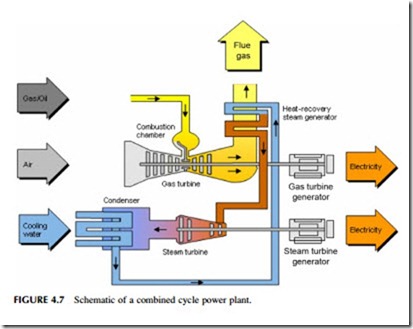COMBINED CYCLE POWER PLANTS
The advanced cycles previously discussed offer the potential to increase gas turbine energy conversion efficiency. Where they have been applied, it has generally been for small generating systems. The most important adaptation of the gas turbine cycle, however, is the combined cycle power plant. This is a configuration that has been adopted and adapted by all gas turbine manufac- turers, and it is capable of the highest energy conversion efficiency yet recorded for a large commercial fossil fuel–fired power station.
The efficiency of a gas turbine for electricity generation is always limited by the fact that the exhaust gases leave the turbine at a high temperature and there- fore still contain a large amount of energy that has not been recovered. Some of the techniques described earlier attempt to use some of this heat energy. However, the most straightforward way of doing so is to add what is known as a bottoming cycle. This is an additional heat engine cycle operating on the low-temperature exhaust.10 For a gas turbine, the best match for a bottoming cycle is a steam turbine.
To integrate the two, the exhaust from the gas turbine is fed into a specially designed heat-recovery steam generator that produces steam from the hot air. This steam is then used to drive a steam turbine generator that produces an addi- tional amount of electricity (Figure 4.7). This basic design is capable of being interpreted in various ways. In some plants there will be a single steam turbine that is fed by steam generated from the exhausts of two or three gas turbines. In others, each gas turbine has its own steam turbine. In some cases these may be integrated on a single shaft with the gas turbine at one end, the steam turbine at the other end, and a generator in the middle driven by both. In this case it will usually be possible to decouple one or both of the turbines from the generator.
The development of gas turbine combined cycle plants since the late 1980s has led to a significant increase in energy conversion efficiency. In 1990, the best efficiency was around 50%. In 2011, a gas turbine combined cycle plant in Germany achieved 60.75% efficiency. Part of this improvement has been due to tight integration of all the combined cycle plant components to reduce heat loss. However, much of it has been due to an increase in the turbine inlet temperature, which has permitted greater thermodynamic efficiency. Inlet gas
temperatures have already reached 1600 oC in the hottest machines developed in Japan where a government program is aiming to make 1700 oC feasible, with a potential combined cycle efficiency of perhaps 65%.
The high efficiency of gas turbine power plants helps keep the cost of each unit of electricity down (though this depends critically on the price of natural gas). They are also attractive because they generate less carbon dioxide for each unit of electricity than other types of fossil fuel generation. In addition, the plants are cheap to build and can be erected relatively quickly because many of the components can be supplied to the power plant site already assembled.
Combined cycle plants can be built in a range of sizes for a few megawatts to several hundreds of megawatts, although sizes are limited by the unit sizes that the different manufacturers offer. While all have a part to play, it is the larger ones that have assumed the most importance in the market.
Originally these large combined cycle plants were conceived as base-load power generation units that would operate at full load for most of the time. The volatility of gas prices during the late 1990s and the first decade of the 21st century has often made this economically unviable and plants have frequently operated at capacity factors much lower than 100%. In the United States the typical capacity factor has been 40% or less in most recent years.
The duty cycle of the gas turbine plant has additionally been complicated by the increasing volumes of electricity entering grids in many parts of the world from renewable power stations exploiting wind or solar energy. The fluctuating output from these sources means that these grids require a secondary source of electricity to maintain the grid in balance. This is a role that combined cycle power plants are being adapted to fill.
To achieve flexibility, manufacturers are modifying the way their combined cycle plants operate. Flexible operation includes being able to generate at much less than 100% load while still maintaining good efficiency. It means being able to start up quickly and being able to change output quickly too, all without compromising either efficiency or emissions performance. Strategies to achieve this include keeping parts of the system continually warm by either heating them or by keeping the plant on-line at very low load (sometimes called parking) when demand is low—sometimes overnight—so that it can return to full output quickly. Various modifications to the way plants operate have allowed plants to change their outputs much more quickly than in the past.
Most large combined cycle plants have one to three gas turbines. However, some manufacturers are also exploring the option of using many more small gas turbines, each with its own steam generator and steam turbine, to provide greater flexibility. Each of the multiple units can then be brought into service as needed. Increasing or decreasing output is then managed by starting up or shutting down another unit so that operating units are at their optimum load for most of the time. This allows overall high efficiency to be maintained over a wide range of loads but at the expense of ultimate efficiency, because smaller gas turbines are generally less efficient than the largest machines.
